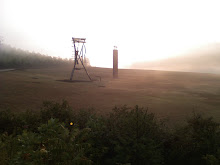 (submitted by Meg Trau)
(submitted by Meg Trau) On Friday, February 29th, a group of environmentally concerned students embarked on an epic journey to the Eco-Manor. After missing the exit by a long shot, we eventually found ourselves on the curb of a beautiful suburban home in Buckhead, Atlanta. For a moment we wondered if this truly was our final destination, for it seemed far too humble to be a “manor.” After a few awkward minutes staring from the sidewalk, we were graciously greeted by Laura Seydell and her glorious assortment of hot pizza. We continued to gorge ourselves on our second lunch and learned how to flush their toilets (left button for “#1”, right button for “#2”), and it was soon time for the first presentation of the day.
A group of Georgia Tech engineering students talked to us about the Solar Decathlon project. Essentially, the goal is to construct an entirely solar-powered house that can be self-sufficient for ten days. Germany won, but we digress. After this presentation, it was time for the tour of the house.
Rutherford Seydell began the adventure with the introduction of the magic panel. This all-encompassing panel could control the lighting, and essentially anything electrical, throughout the house with the push of a button. It even had a “party” setting – fancy! It also monitored energy consumption and savings and other such important data. Before continuing upstairs, Laura Seydell pointed-out various environmentally aspects in the house, such as VOC-free paint and household objects (such as curtain rods) made from recycled materials. Every minute detail contributed to the green aspect of their home.
We then journeyed upstairs to the bedrooms where Mr. Seydell explained solar tubes. They are essentially more effective sky lights that use reflective paper that optimize the natural lighting that illuminates the room. Next, we ascended to the roof where we found a blanket of energy – solar panels, that is. Our very own Senora Carlson had a bright idea which would increase their effectiveness (this same idea was suggested by a professional just days earlier!). En route to the roof, we were able to see the insulation, a foam made from soy, and other insulating substances such as recycled paper. From the very top we descended into the depths, the basement. It is the entertainment hub of the house, but that does not make it less environmentally-minded. Also housed in the basement is the water-filtering system. We all crammed into a closet-sized room to see how it was done. Mr. Seydell explained that rainwater and gray water from showers and such things are reused to accomplish miscellaneous tasks such as watering the lawn and flushing the toilets. The Seydells could monitor all of the water, electricity, and greenhouse gasses they were saving by looking at a monitor, which was the brain of the water system. After this explanation, we met one of the men behind the magic; as we were preparing to depart Mr. Seydell’s next appointment arrived. We briefly talked with him about the installment of solar panels. After that we took our leave and took note of the permeable drive way and the water drainage collectors. We then traversed back to our parked buses and departed to return to our lovely home.
We took back with us knowledge that we hope to disseminate across our growing campus and various communities


No comments:
Post a Comment